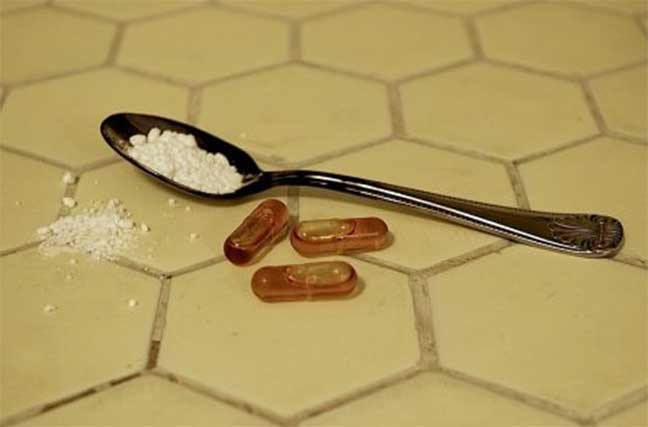Krokodil (Desomorphine) | Facts, Side Effects, Abuse Potential, & Warnings

Medically Reviewed By: Manish Mishra, MBBS
Krokodil (desomorphine) is less well-known than other opioid derivatives, but it’s just as potent and dangerous. It has no legitimate medical use and can severely damage the skin leading to gangrene and even amputation when abused. Krokodil use also increases the risk of overdose and addiction.

Krokodil is the street name for the opioid derivative and analgesic desomorphine.
Abuse of the designer drug started internationally in 2002, and it can lead to very serious side effects. The side effects can get so serious that limbs need to be amputated because the skin is so damaged that it needs to be removed entirely.
Krokodil Facts
Desomorphine is a synthetic opioid-like substance that was first created in the 1930s in the United States. People in Russia and Ukraine are currently the most affected by the use of this drug.
Street Names & Effects
Desomorphine has a number of street names including Krokodil, Russian Heroin, Russia Magic, and Crocodil. Like many opioids, the effects come on fast but can last for less than two hours.
Due to the short duration of the “high,” many users find themselves in rapid repetition of drug use to avoid withdrawal symptoms.
It’s also about ten times more powerful than morphine.
How Desomorphine Is Made
Desomorphine is often made by mixing codeine with organic solvents like gasoline, paint thinner, lighter fluid, red phosphorus, and hydrochloric acid. This makes a synthetic form of heroin. It’s typically used as an intravenous drug and injected into a vein.
Flesh-Eating Drug
For those who abuse the drug long-term, the effects can include greenish, scaly skin due to damaged blood vessels, thrombophlebitis, as well as damaged soft tissues. The green, scaly effect the drug can lead to is where it gets its street name.
It’s also why it’s known as a “flesh-eating drug.”
The street name Krokodil also refers to chlorocodide which is a derivative of codeine and what Krokodil is made from.
Side Effects Of Krokodil
Krokodil use can lead to very serious side effects that can negatively affect your health and overall well-being. Some of the side effects include:
- gangrene: a discolored (green-black) scale-like skin that resembles a crocodile
- severe infection leading to amputation and/or death
- severe tissue damage or necrosis
- extreme skin ulcerations or infections
- serious vein damage
- pneumonia
- blood poisoning (bacteremia)
- meningitis
- rotting gums or tooth loss
- bone infections (osteomyelitis)
- osteonecrosis
- speech and motor skills impairment
- memory loss
- impaired concentration
- liver and kidney damage
- overdose
- slowed or stopped breathing
Abuse Potential Of Krokodil
Desomorphine is classified by the Drug Enforcement Administration (DEA) as a Schedule I controlled substance.
That means it has no legitimate or accepted medical use, has a very high potential for abuse, and can easily lead to physical and psychological dependence and addiction. Heroin, LSD, and meth are also in this classification.
Krokodil Warnings
Krokodil comes with a number of dangers and warnings as well. With Krokodil, there is an increased risk of gangrene, cognition issues, addiction, and overdoses.
Gangrene
Using and abusing Krokodil increases the risk of gangrene setting in. When this occurs, it also increases the risk of the need for amputation.
When Krokodil is injected into a vein, it can damage the blood vessels and or even kill the tissue at the injection site. That’s what can ultimately lead to gangrene.
Cognition & Sleep Issues
People who use Krokodil also increase their risk of cognitive and sleep issues. There is a risk of exhaustion, memory loss, and problems with speech as well as sleep deprivation. Sleep deprivation can also lead to even more exhaustion and exacerbate the cognitive problems.
Dependence & Addiction
As a Schedule I controlled substance, there is also an increased risk of dependence and Krokodil addiction when using the drug.
If you build up a dependence, it makes it very difficult to stop using. Your body can no longer work properly without it, and if you do try to stop, severe withdrawal symptoms may occur.
A detox program as well as addiction treatment services will likely be necessary to safely come off the drug completely.
Overdose
Because of the high potency of Krokodil, it is very easy to overdose on the drug. Some of the signs and symptoms of a Krokodil overdose include:
- unresponsiveness or unconsciousness
- slowed or stopped breathing
- snoring or gurgling sounds
- cold or clammy skin
- discolored lips or fingernails
- coma
If you or a loved one are showing any of these signs and symptoms, call 911 immediately.
Treating Desomorphine Abuse
If you or a loved one are struggling with any form of opiate/opioid use disorder or drug abuse, the experienced team at Ohio Recovery Center is here for you.
We offer a variety of addiction treatment options including detox, inpatient drug rehab, medication-assisted treatment, and aftercare support.
To learn more, please call our helpline today.
- CNN https://www.cnn.com/2013/10/16/health/krokodil-zombie-drug/index.html
- Drug Enforcement Administration (DEA) https://www.deadiversion.usdoj.gov/drug_chem_info/desomorphine.pdf
- JAAD Case Reports https://www.ncbi.nlm.nih.gov/pmc/articles/PMC4864092/

